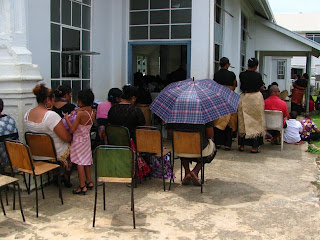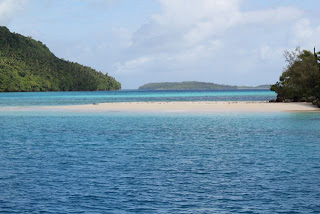Before setting off on our cruise through
the island world of Fiji we decided that Johnny was a worthwhile
recipient of some of PasoDoble's ‘5% project’ funds. About 12 years ago Johnny suffered an
accident, which left him a quadriplegic. He now receives a disability pension of
65 Fijian dollars per month and needs to support his family with selling
necklaces on the street. We hoped our small contribution would bring at least some
short-term relief.
Another urge we needed to satisfy was a
dive with the Jean-Michel Cousteau resort to the renown Namena Marine Park dive
site. A few different factors need to coincide, but we were lucky. The weather gods provided a flat sea for the 20miles or 35 minutes trip in a 500hp speedboat and the luxurious resort came up with the 3
more divers to bring it up to the necessary number 5 to make to trip possible.
It was worthwhile as the dive was magnificent. Large coral heads at their best
architecture and condition, at a depths of 25 to 35 meters and at the edge of
the reef a steep drop to about 600m. Perhaps the word awesome describes it best.
Unfortunately we have no underwater pictures of the dive …
… but were sufficiently motivated wanting
to return to the marine park the following day with Paso Doble. This time under sail, the slow motion trip with a
fresh breeze took about 4 hours. Entering the reef via the North Safe-a-Tack Pass, we tied up to a mooring buoy just before dark at Namena Island. The next day we snorkeled the reefs
surrounding the boat and although lacking the excitement of depths found it
almost as satisfying as the dive. The corals and fauna were simply wonderful.
We had plans for an overnight sail straight
to the Yasawa Islands in the west of Fiji and left the Namena reef via the
South Safe-a-Tack Pass - facing a wall of black sky; no mention of that in the
weather forecast. About a mile outside the reef the skies opened and the wind
started to blow with 30 knots from the west, exactly where we were headed for.
About 2 hours later we were still a mile from the reef pass and gave up,
changed tack and started to head south. With the wind abeam now we sailed
briskly down towards the main island of Viti Levu, hoping that the wind would
turn by the time we reached the next reef channel. By 1700h the wind was still
westerly and we made for an anchorage in the lee of Makogai Island, hoping for a
change of wind overnight.
We woke up to good news the next morning –
the boat was facing south. We weighed anchor and continued with our plan of the
overnight sail, only this time the wind came from aft quarter and we ‘broad
reached’ up through the Vati-i-Ra channel towards the Yasawas. The timing was
for a dawn arrival at the Qio Pass leading into the Tivolei reef. We got there
at 0700h and managed to sail trough the narrow passage without changing sail –
perfect. At 0900h we slipped through the Tamasua Pass and put down our anchor
in the lee of Sawa-i-Lau Island, right outside the steps to the limestone
caves.
Soon after the beach in front of the caves
came alive with Fijian vendors setting up their stalls getting ready for the
daily water taxis loaded with resort tourists from the surrounding islands. After
all the activities were over, vendors gone and peace returned we checked out
the cave. The angle of the afternoon sun was perfect for the rays to shine
through the skyward opening and set the cave alight. The corals in front of the caves were also
very pretty and it was easy to while away a few hours with snorkeling.
The following day we left the bay and
motored down the lee side of Nacula Island to the most famous of all Yasawa
spots – the Blue Lagoon. The midday sun helped navigating through the reefs
protecting the lagoon and we put down the hook right where Brooke Shields might
have swum all these years ago. That night we went to the adjoining Coral View
resort for a traditional ‘Lomo’ earth-oven cooked meal, however
the ‘fire dance’ performed by the staff made up for the very average meal.
We organized a last South Pacific dive at the same resort, but the Namena dive was a hard act to follow. It also pointed
out that after the very professional Cousteau dive outfit one should be choosy
with whom to go diving … although we were lucky and got away with a minor
inconvenience, the combination of a few smaller issues could have resulted in a
major problem.
We left the Blue Lagoon and headed out the
channel to the west. We decided to take advantage of a fresh breeze for a brisk
sail down the outside of the islands rather than weaving our way through the
seemingly endless reefs within the group. Our next stop was off the beach next
to the village of Yamata on the island of Wayalailai. No sooner did we drop the
anchor we got a visit from Ili in his tin canoe, who sold us 5 plate size reef
fish – dinner was organized.
In the late afternoon another canoe stopped
by. Steven was on the way to his ‘night shift’ of lobster hunting and promised
us some for the next morning. Well, he turned up at 0730h with his catch ...
and dinner was organized again. He stayed for a chat and some morning tea.
Following an invitation to his village we later on met some of his extended
family clan and acquired some locally made souvenirs.
Then we left the Yasawas and headed off to
Monuriki Island in the northern Mamanuca group. This island is nicknamed Tom Hank’s
island in most guidebooks, after the movie Cast away. One thing is sure with
these places made famous by Hollywood movies – they pick spectacular locations.
The next few windy days were lazily spent
beach combing and snorkeling around the sand spit before the inevitable last
port for this leg called – Musket Cove Marina on Malololailai island. Heading
into a southeasterly wind we sailed [motor assisted] through the southern
Mamanunca islands and entered the protecting reefs of the Malolo group. Originally sold for one
musket, Dick Smith had a vision for this cove and in the 1960’s acquired it for
a quite a few more muskets, turning it into a resort and marina. We tied up
stern-to, connected to the civilized world of running water and power and gave
PasoDoble the fortnightly scrub-down.
We aptly finished off this leisurely
holiday leg with a Fijian dinner and traditional song night at the resort – at sunset …
life’s tough
Officialdom had to be dealt with again to
be able to leave the country. Lautoka is the clearance port for this area of
Fiji, some 60 km away from Musket Cove on the main land of Viti Levu. We got
there by ferry and bus and were quite put off by custom's refusal to clear us out; further more demanding that we actually present the boat at the port of Lautoka for inspection. This was
completely contrary to what we were told by the customs officer in Savu Savu.
Trying a number of more or less diplomatic approaches from ‘sweet talk’ to
‘please-please-please’ to ‘I will have to lodge an official complaint’ got us
no results … it meant going upwind for a whole day and through a stretch of
water littered with reefs – thank you very much, Mr Custom's Officer.








































































